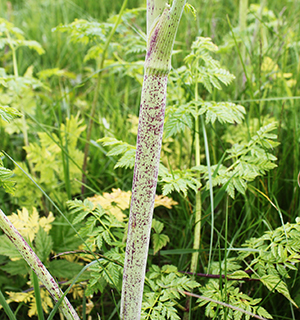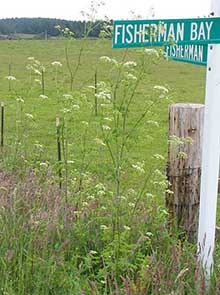— from Judy Jackson, Noxious Weed Control Program —
 In 2009, 17 poison hemlock exposures were recorded by the Washington Poison Center. In 2010, a Bellingham man was hospitalized after having eaten what looked like a baby carrot growing in his garden. The same year a Tacoma woman died after accidently ingesting this deadly plant. This year, the Washington Poison Center reports it has already treated ten people who have eaten this highly toxic plant.
In 2009, 17 poison hemlock exposures were recorded by the Washington Poison Center. In 2010, a Bellingham man was hospitalized after having eaten what looked like a baby carrot growing in his garden. The same year a Tacoma woman died after accidently ingesting this deadly plant. This year, the Washington Poison Center reports it has already treated ten people who have eaten this highly toxic plant.
Poison hemlock is a potently poisonous member of the parsley family and when young, is easily confused with other more benign members of this family, such as Queen Anne’s lace, wild chervil or domestic carrot. It may be distinguished chiefly by its lacey, fern-like leaves, its height (up ten feet), its purple-blotched stalk and unpleasant odor. Poison hemlock’s stems and leaves are smooth and hairless, whereas those of Queen Anne’s lace are hairy.
All parts of the plant are poisonous and only small amounts can sicken or kill both humans and animals. In ancient Greece, hemlock was a classic executioner’s potion and was used to execute Socrates. Its toxic alkaloids initially will cause stimulation followed by severe depression of the central nervous system, resulting in death by respiratory paralysis. Symptoms may appear one to three hours after ingestion, and include nausea, vomiting, dilation of the pupils, confusion, sweating, and rapid heartbeat. There is no antidote. Touching the plant may cause skin reactions in some people (Turner et al. 1991*).
Cattle are the most susceptible of livestock but all classes of animals are affected by this plant’s toxicity. Poison hemlock can also cause birth defects when consumed by pregnant animals. Animals will normally avoid fresh plants, however, when dried, poison hemlock loses its characteristic “mousey” odor, becoming more palatable, but remaining toxic.
Poison hemlock is a Class B designated noxious weed in San Juan County, and control is required. Although commonly seen along roadsides, and in open fields on the mainland, it is only sparsely scattered throughout the islands. It has been found in gardens, pastures, gravel pits and in other disturbed areas. On San Juan Island, it was discovered inside a fenced community garden growing next to carrots, and on Shaw, it was found growing just outside a garden. It thrives in cool, moist climates, making it well adapted to the climate of the San Juan Islands.
Wear protective clothing (including a long sleeved shirt, gloves and eye protection) when working with poison hemlock. In the winter and early spring, rosettes and bolting plants can be dug out. Mature plants can be cut or mowed when they are in flower but before all flowers completely open. If cut earlier, the plants will regrow. Remove all cut plants from gardens, pastures, play areas, since cut plants remain poisonous and chemicals leaching from the decomposing plants suppress the regrowth of other vegetation. Do not burn the remains, as the smoke may be toxic. Appling a layer of cardboard will suppress poison hemlock and its seed bank, which should only be viable for about three years. For chemical control, a glyphosate product can be applied with a brush or spot sprayed on individual rosettes. If you choose to use an herbicide, follow label instructions. The label is the law.
To help keep poison hemlock from spreading further in the islands, ask for noxious weed-free soil and gravel. If you wish further information, or would like to schedule a free site inspection for noxious weeds, please call either Judy Jackson or Jason Ontjes at the County Noxious Weed Control Program office (360.376.3499).
* Nancy J Turner & Adam F. Szczawinski July 1999. Common Poisonous Plants and Mushrooms of North America, Timber Press
**If you are reading theOrcasonian for free, thank your fellow islanders. If you would like to support theOrcasonian CLICK HERE to set your modestly-priced, voluntary subscription. Otherwise, no worries; we’re happy to share with you.**








